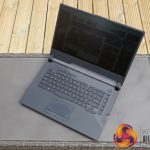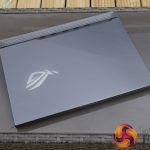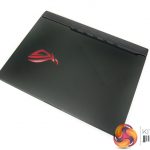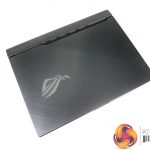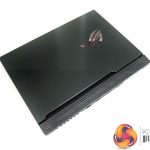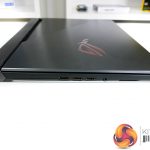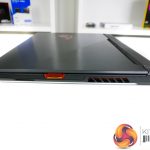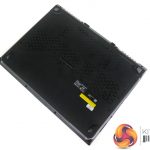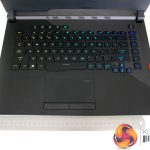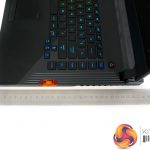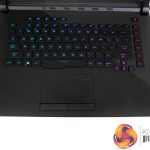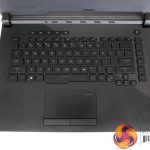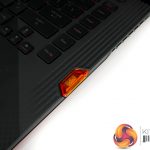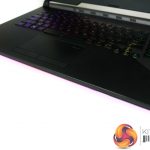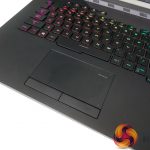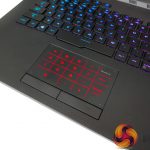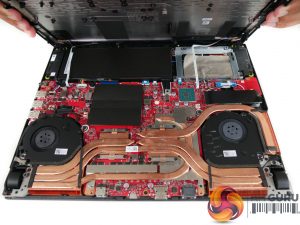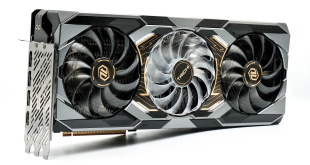Built primarily from plastic, the ASUS ROG Strix Scar III has a sleek, understated look in its grey and black colour scheme. The faux-brushed metal cover has good fingerprint resistance and looks attractive when reflecting light. Build quality is excellent, with good rigidity throughout and a manageable amount of flex on the screen.
The light-up ROG logo is a nice touch which adds to the premium feel. There is a decent amount of venting on the underside plastic shroud, though most of the air intake and exhaust is handled by back and side vents.
Port selection is good, with three USB 3.1 Gen 1 (5Gbps) Type-A, 3.5mm audio jack, RJ45 Gigabit Ethernet, HDMI 2.0b, and one Type-C connector that provides USB 3.1 Gen 2 (10Gbps) and DisplayPort connectivity.
All three Type-A USB connectors being positioned on the left side is my biggest complaint with respect to ports. The wire from a mouse will likely be trailing behind the screen. Spacing for the Type-A ports is not ideal, either, with a wider-than-average connector such as an SD card reader likely blocking its neighbouring port.
The G531GW measures in at 36cm wide, 27.5cm deep, and 2.6cm thick. Weight is just under 2.4kg, according to ASUS' specifications. Vents at the rear of the chassis extend past the screen hinge, thus limiting the maximum rotation angle slightly.
Per-key RGB lighting on the chiclet keys is strong, bright, and can be controlled easily. N-Key rollover is supported, and ASUS provides a good number of dedicated hotkeys. The NFC-enabled Keystone chip is inserted on the right-side of the laptop and fits well with the overall styling, adding a small touch of orange contrast.
Holding the num lock button on the well-designed track pad reveals the number pad lighting. I am particularly fond of the dedicated right and left click buttons, which are superior to the all-in-one trackpad, in my opinion.
Accessing the internals is challenging as there are two ribbon cables that connect the RGB lighting on the bottom of the chassis. These cables feature small connectors and will be very difficult to re-insert once removed. As such, an extra pair of hands is strongly advised when working inside the G531GW.
Two blower-style fans take care of the Core i9-9880H CPU and the RTX 2070 GPU, along with a fleet of heatpipes. A pair of SO-DIMM slots takes DDR4 memory and come pre-installed with 2666MHz SK Hynix sticks in our 32GB test configuration. The Intel 660p NVMe SSD is covered with a thermal pad and a thin black cover.
ASUS has clearly prioritised additional storage capacity (and lower cost) by opting for a relatively small 66WHr Li-ion 4-cell battery. Opting for this size of battery does, however, make a spare 2.5″ drive bay available for SSD or HDD storage upgradability.
 KitGuru KitGuru.net – Tech News | Hardware News | Hardware Reviews | IOS | Mobile | Gaming | Graphics Cards
KitGuru KitGuru.net – Tech News | Hardware News | Hardware Reviews | IOS | Mobile | Gaming | Graphics Cards





